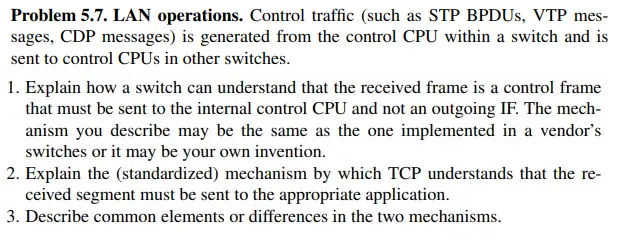Homework Help: Questions and Answers: Control traffic (such as STP BPDUs, VTP messages, CDP messages) is generated from the control CPU within a switch and is sent to control CPUs in other switches.

- Explain how a switch can understand that the received frame is a control frame that must be sent to the internal control CPU and not an outgoing IF. The mechanism you describe may be the same as the one implemented in a vendor’s switches or it may be your own invention.
- Explain the (standardized) mechanism by which TCP understands that the received segment must be sent to the appropriate application.
- Describe common elements or differences in the two mechanisms.
Answer:
Handling Control Frames in Switches
1. How a Switch Recognizes Control Frames and Sends to Internal Control CPU:
Switches use special Ethernet destination MAC addresses to identify control frames like STP (Spanning Tree Protocol), VTP (VLAN Trunking Protocol), and CDP (Cisco Discovery Protocol) messages.
These frames are typically processed differently from regular data frames and sent to the control plane (the internal control CPU). Here is the mechanism:
- Reserved MAC Addresses: Control frames often have a destination MAC address that is reserved for special purposes. For example:
- STP BPDU frames are sent to the MAC address
01:80:C2:00:00:00, which is a reserved multicast address used specifically for the STP protocol. - CDP frames use a Cisco-proprietary multicast address
01:00:0C:CC:CC:CC.
- STP BPDU frames are sent to the MAC address
- Multicast and Reserved Address Recognition: The switch has a mechanism that monitors incoming frames for these special MAC addresses. If an incoming frame contains a destination address that is within a range defined as “reserved,” the switch forwards it to the control CPU instead of switching it to an outgoing interface.
- Access Control List (ACL): Some switches may use ACLs to identify and handle control frames. When a frame matches specific criteria defined in an ACL, it is redirected to the control plane.
- Punt to CPU: Once identified, the switch “punts” the frame to the control CPU. This means the frame is diverted from the regular forwarding path and sent to the internal processing unit for handling.
Conclusion:
The mechanism relies on recognizing reserved MAC addresses, multicast addresses, or ACLs to classify control frames and send them to the control plane for further processing.
TCP Handling of Received Segments
2. How TCP Understands That a Segment Must Be Sent to the Appropriate Application:
The mechanism by which TCP determines which application to forward the received segment to is defined by the Transport Layer (Layer 4) of the OSI model, using port numbers:
- Port Numbers: Each TCP segment contains a source port and a destination port in its header. These port numbers uniquely identify the sending and receiving applications. For example, port
80is typically used for HTTP, and port443for HTTPS. - Socket Matching: A TCP segment is matched to a specific application by looking at a combination called a socket, which consists of the IP address and the port number. The operating system maintains a TCP socket table, where each entry maps a specific port number to a process (an application).
- Demultiplexing: When the TCP segment arrives at a device, the TCP layer examines the destination port number and consults the socket table to determine which application the segment should be delivered to. This process is called demultiplexing.
- Queueing to Application: Once the appropriate socket is found, TCP places the segment in the receiving queue for that application, and the application can then read the data.
Conclusion:
TCP uses destination port numbers to determine which application should receive a specific segment by consulting a socket table and then demultiplexing the segment to the correct process.
Common Elements or Differences in the Mechanisms
Common Elements:
- Classification: Both mechanisms involve classifying incoming messages. In switches, this is done based on the destination MAC address, whereas in TCP, it is based on the destination port number.
- Redirection to Specific Handlers: Both mechanisms redirect traffic to a specific internal entity for processing. In switches, control frames are sent to the control CPU, while in TCP, segments are delivered to the appropriate application.
Differences:
Layer of Operation:
- The switch mechanism operates at Layer 2 (Data Link Layer), using MAC addresses to determine where control frames should go.
- The TCP mechanism operates at Layer 4 (Transport Layer), using port numbers to direct segments to specific applications.
Purpose:
- The switch mechanism is intended to handle network control protocols (e.g., STP, VTP) to manage and maintain the network infrastructure.
- The TCP mechanism is designed for application-level communication, allowing end-user applications to exchange data.
Types of Addressing:
- The switch uses MAC addresses to determine where a frame should be handled.
- TCP uses port numbers to determine which application process should handle the incoming segment.
Conclusion:
Both mechanisms are used for handling control or specific traffic, but they operate at different layers of the OSI model and use different addressing methods to classify and forward incoming messages appropriately.
Learn More: Homework Help
Q. Which key factor helps to differentiate companies who want to use Al to?
Q. Which sentence about digital literacy at work is true?
Q. Strong endpoint anti-malware can be used to minimize which of the following threats?
Q. Which of the following best describes the difference between software and hardware?